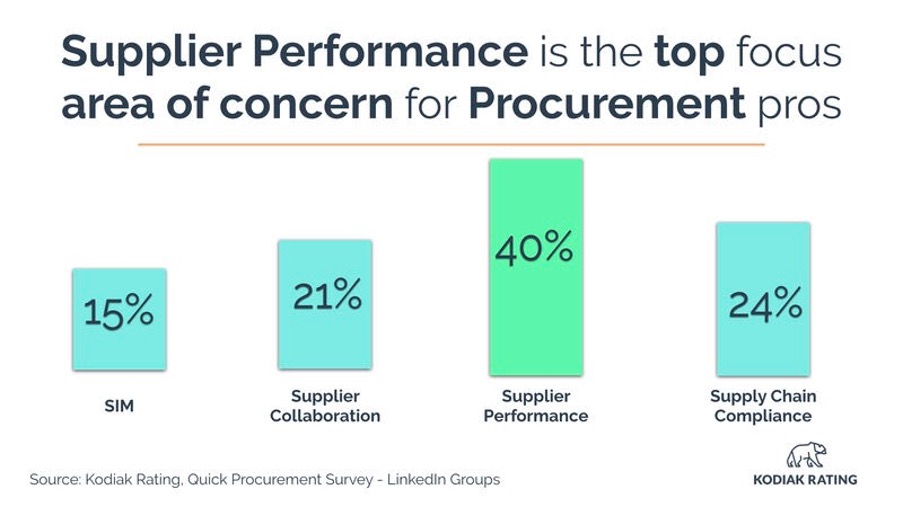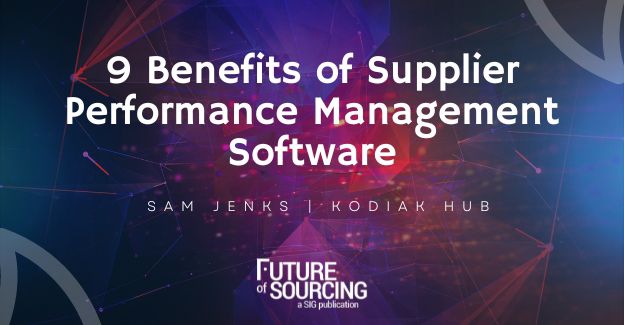Procurement professionals are concerned with addressing supplier performance management (SPM) and understand the value it brings to their overall excellence, but almost 50% of teams don’t actually follow up on supplier KPIs, says Sam Jenks, Chief Growth Officer at Kodiak Hub. He shares nine benefits of utilizing SPM software and seven quick tips to get started.
About 65% of innovations are sourced through external suppliers and partners (ISM). This makes supplier and partner contributions to a supply chain’s production and profitability rather pivotal.
Put into simple math: Good supplier performance = good supply chain performance.
Supplier performance management (SPM), when done right, can help your procurement organization to harness supplier performance and innovation to positively impact your business’ top-line value creation.
SPM is an area that can be challenging for global procurement teams, as supply chain complexity continues to grow.
Unfortunately for many procurement teams, gaining basic buyer insights from their supplier base, such as contract, spend, performance, risk and compliance data isn’t so easy to get a hold of or begin to analyze. Even in the most mature of procurement organizations evaluating and managing a supplier base’s performance can be difficult.
Kodiak Hub surveyed 526 procurement and supply chain professionals on LinkedIn asking what focus in supplier management is their biggest area of concern? As seen in the graphic below, 40% of respondents listed supplier performance as their top area of concern.

At the same time, nearly half of procurement professionals who responded in the 2021 Supply Chain Resilience Report by BCI (below) said that they don’t harness any kind of technology to follow up on supplier performance KPIs.

These two statistics highlight a clear yet confusing discrepancy.
Procurement professionals are concerned with addressing Supplier Performance Management and understand the value it brings to their overall excellence, but almost 50% of teams don’t actually follow up on supplier KPI's.
Maybe this stems from a lack of time, overly complex supply chains or a simple lack of resources. No matter the reason, one harsh truth remains: you can’t manage what you can’t measure.
If you’re still reading it means we’ve made it this far in the article together. That means the above statistics may resonate with you. No need to worry. We’re not going to utilize this article as an opportunity to reprimand or scold you for a lack of SPM. Quite the contrary.
You likely know the importance and benefits of supplier performance management.
But maybe you’ve gotten discouraged along the way or don’t know where to start.
We will use this opportunity to inspire you to get back on the horse and provide some tips to get started with supplier performance management.
9 Supplier Performance Management Software Benefits
- Enhanced Supply Chain Visibility – Better supply chain visibility brings you closer to the pulse of your supply chain, giving you a better means to forecast and avoid costly supply chain disruptions.
- Supplier Accountability – Supplier performance management systematically and implicitly expresses expectations and KPI acceptance criteria to your suppliers. This in turn allows the supplier to take accountability for their own performance and activities as partnerships are entered with a transparent framework for ideal performance, from the start.
- Supplier Led (Enabled) Innovation – As stated in the first line of this post, 65% of innovations are supplier and partner-led (ISM). Communicating the importance of performance and innovation ambitions to partners welcomes them to more openly share their unique insights, industry-specific competency and capacity for innovation. Remember: your suppliers are experts in their field! That’s why you started working with them in the first place. An SPM process will help you systematically listen to and absorb what they have to say!
- Quality Performance (Product & Services) – Follow-up on product and service quality is a straightforward win from SPM. Systematic measurement, reporting and analysis of supplier quality (deviations, complaints, claims, project quality, etc.) will help you to cut out suppliers that aren’t making the cut and bring better quality products and services to your end customers.
- Easy Follow-up on SLAs – A service-level agreement (SLA) defines the level of service you expect from a vendor and lays out the metrics by which service is measured, as well as remedies or penalties should agreed-on service levels not be achieved (CIO.com). SPM aids definition, measurement, follow up and actions for agreed-upon SLA's. Contract compliance can be challenging, but solutions for SPM make it cut and dry.
- Increase Buyer-Supplier Collaboration – SPM software provides a common platform to enhance buyer-supplier relationships and collaboration. As said before: simple things like beginning a supplier relationship with clear expectations can prove to build trust, respect and mutual goals.
- Spot Best and Worst Suppliers Faster – Utilizing technology to measure and analyze supplier performance KPIs will provide your team with a better means for data visualization and therefore a better means to spot best and worst performing suppliers.
- Make Sourcing and Procurement Decisions Data-Driven – Make systematic and data-driven decisions a priority. SPM will give you the insights you need to make more data-driven decisions, but if you choose to act upon them, it will still require the EI (Emotional Intelligence) and HI (Human Intelligence) that makes you a talented procurement professional in the first place.
- Align Team on Business Goals – Sometimes broader business initiatives can feel very distant. Aligning within your procurement team on a supplier performance management framework, system and process will allow your team to have a more holistic understanding of how greatly supplier performance impacts the broader business (such as how performance creates an opportunity for savings, innovation, brand-value creation, competitive edge and more).
Change can be overwhelming. Sometimes, that feeling can become the barrier to jumpstart change at all. But, in order to apply supplier performance management tools and adopt a framework that will make an impact in your organization, change is inevitable. That’s why I’ve laid out these tips below on how to get started:
7 Quick Tips To Get Started With Supplier Performance Management Solutions
1. Align on KPI's
Workshop with your team to determine how you’d like to evaluate supplier performance.
You can break up supplier performance KPI areas into six parameters:
supply chain, quality, commercial, collaboration, innovation and sustainability performance.
Locating these key performance parameters is important to build sub-parameters and eventually find individual data feeds to structure your performance evaluations properly. See the graphic below to understand how these KPI trees can be built:

As you begin to define the content of these various KPI tiers, you’ll need to align stakeholder expectations, requirements and preferences. Team members will likely have strong feelings about what should be measured and how it will be measured, but it’s important to remember that the end goal is a common one: to improve your supplier performance management.
2. Take a Broader Stakeholder Perspective
In order to align on KPI's and have robust criteria for supplier performance evaluation, you need to locate KPI's that are outside of the scope of solely procurement, sourcing and supply chain.
To achieve a broad range of stakeholder perspectives you’ll need to include production, quality, sustainability, finances, even sales and marketing in order to truly capture the various supplier KPIs that exist within the broader value chain. This will help you to bridge functional gaps and gain perspective for the necessity of supplier performance within various functions. This may require a development and program manager or a project owner to align supplier KPIs, targets and goals cross-functionally.
3. Typify/Segment the Supplier Base
Supplier performance management and evaluation should be adapted based upon a supplier’s characteristics or a supplier type. It’s important to evaluate supplier performance in line with supplier typification. This could be based on category, country, spend, criticality or other typifications.
4. Don’t Forget About Governance and Risk Parameters
A supplier that lacks quality management will likely not excel in quality performance. If they show high-quality performance but lack management capability this discrepancy could also cause issues.
Taking Governance and Risk into consideration will give you a 360º picture of a supplier’s overall performance and it will ensure that your supplier partners won’t negatively impact brand or shareholder value.
5. Know What’s Going On
We’re living in a new reality where the value of a brand is directly linked to and impacted by the operational activities of a global supply chain and its many tiers. Consumers aren’t sympathetic to supply chain complexity.
If something happens in the world, you need to know about it.
If you have a global, complex or large supply chain, then media monitoring of some sort is suggested to stay on top of current events, news, happenings, updated sanctions, blacklists and more.
6. Locate the Right Data
Do you need to send a performance evaluation to an internal stakeholder or a supplier or both? Do you need to send a performance evaluation to multiple stakeholders? If so, do all stakeholders need to respond to every area of the evaluation? Most importantly, do you already have the responses to the evaluation in another business solution, such as an ERP or quality solution?
Take the time to locate where your supplier performance data can be sourced from, and it will streamline the process of gathering information. This will save your team time and headaches.
7. Adopt a Rating Methodology
Supplier ratings will help you spend less time with your nose in an excel spreadsheet and give you more time to drive value with the right suppliers at the right time.
Much of performance evaluations are based upon qualitative experiences and evaluations of a supplier's performance. Focus on quantifying the qualitative. Create opportunities to make your supplier evaluation criteria into a multiple-choice format. The more you can turn into multiple-choice options, the more you can weigh the questions you ask, and automate the scoring of responses, which will also serve as a time saver.









